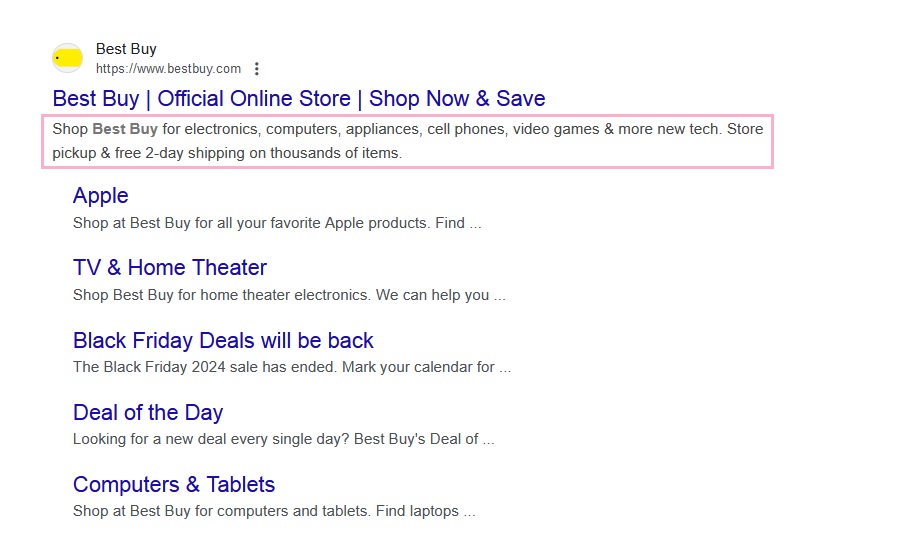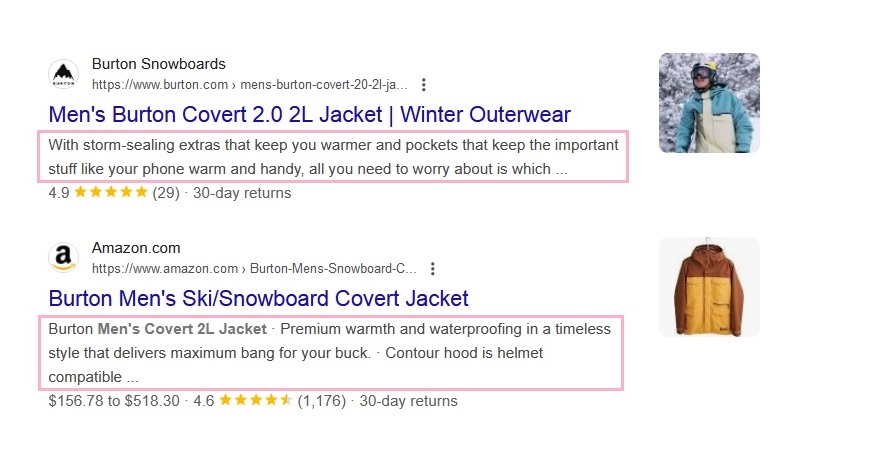
Writing meta descriptions is a crucial part of on-page SEO. If you run a website, you’ll need to create a short summary for the content of every web page for users to read and generate CTR from search engines. Whether or not you have written these descriptions yourself, you must have seen them right below a website’s or page’s URL and title in Google search results pages.
In this guide, we’ll discuss in detail what meta descriptions are and how to write good meta descriptions in order to properly optimize your web pages for search, driving users to click through to your website.
What is a Meta Description?
Technically, a meta description is an HTML tag or element that you can set for a page of your website. This is a way of summarizing the content of a web page in around 155 characters. Google can choose to display this brief summary as a snippet beneath your web page’s title in SERPs.

When it comes to the appearance of meta descriptions in search engine results, one of the two things can happen; either Google picks and shows your specifically-written meta description or it will generate a suitable snippet for a page on its own. In any case, the purpose of this SEO summary is to inform users what your page will offer them. Based on the quality of the meta description, users will decide whether they would like to click through and visit your website.
Google’s selection of the snippet is based on its specific understanding of the user’s search intent. This indicates that the phrasing of your meta description should be done in an appropriate manner.
Think of a meta description as a promise you make to searchers in regard to what your page’s content is about. Provided you craft your SEO meta descriptions in adherence to the best practices, you’ll be able to make your web pages stand out quickly among a large number of competing pages and incite users to click on your links, driving more traffic to your website as a result.
How to Write a Good Meta Description
Now that you have clarity on what meta descriptions are and why they matter for your website’s SEO, it is time to learn how to write them effectively. There are some basic guidelines and best practices that you should follow in order to write meta descriptions for increased search visibility and CTR.
I) Stick to the Optimal Length
What is the recommended length of a meta description? The optimal length for writing meta descriptions is 1555-160 characters. While you can make these summaries longer than this, the only problem is that it won’t be of any help. No matter how long your meta descriptions are, Google chooses to display only a maximum of 160 characters while truncating the remaining part of it.
Since shortened meta descriptions can hurt the click-through rates, it is always best to limit their length to 160 characters.
II) Make it a Good Match for the Page’s Content
Just because the goal of a meta description is to generate clicks, it doesn’t mean you should trick people into clicking on your links. It is an unethical practice to overpromise and under-deliver to readers.
Google discourages businesses from indulging into such shoddy practices and it might even penalize you for the same. In any case, deceptive SEO descriptions will only lead to a higher bounce rate, which in turn, will diminish people’s trust in your products and services and your company as a whole. That is why it is crucial to create relevant and fitting descriptions for every page.
Meta Descriptions that perfectly align with the content of a web page increase the CTR and indirectly boost search rankings.
III) Make it Unique
Web pages with identical meta descriptions negatively impact user experience. Even if the meta titles are different, identical SEO descriptions will make the pages appear the same. In fact, you’d better leave this HTML attribute blank than setting them up with duplicate text across web pages.
It isn’t hard to create unique descriptions for every page of a website. While writing SEO descriptions, you should focus on describing what type of content a specific web page contains. Start with the most important pages first and then move on to the remaining ones. If you have a difficult time writing the right meta description, just think about your unique offer and your competitive advantage. And include the information in the SEO meta description to make it uncommon. Likewise, you can create good descriptions for the service pages on your website.
Summarize the content of a page in a way that first captures the user’s interest and then encourages them to take action.
IV) Include Your Target Keyword
When you summarize a page’s content to create a description, you should include your focus keywords in it. Keywords make it easy for search engines to understand what a specific page on your website is about.
Just like you incorporate the main keywords into the body text, titles and headings, you need to have them into your meta descriptions as well. Inclusion of keywords increases the prominence of your descriptions when Google bolds those words that appear in the search term or are synonyms. This doesn’t, however, mean you should fill your meta descriptions with too many keywords like “best dentist for teeth whitening, best teeth whitening treatment, and teeth whitening dentist. Such spammy practices will hurt both your brand image and your SEO.
Keyword stuffing goes against Google’s spam policies, and it can result in your page or website getting penalized. Instead, incorporate keywords into your descriptions in a way that looks natural and makes sense.
V) Add a Call to Action
A call to action (CTA) is a piece of content that compels users or readers to perform a specific action. Using them in your descriptions generates clicks. Meta descriptions with no proper CTA will fail to prompt clicks.
Here are some examples:
Discover the best gym shoes
Learn the essentials of cake-making
Get great deals on the latest smartphone brands
Explore a wide range of computers
Shop for Kids’ clothes
CTAs and sentences that ask users to do something start with an action word. Using words such as Discover, Learn more, Find out and shop online prove to be quite useful in boosting click-through rates. When you write SEO descriptions for pages, you should definitely include CTAs effectively. Just ensure the verbs you use correctly reflect the user’s need that a particular page fulfills.
Writing Meta Descriptions for Homepages
Creating descriptions for homepages isn’t easy. You’ll understand this as soon as you start writing one for your own website.
A homepage is the principle page of a website. This is the page that visitors see as they type in the browser the URL of a website. Though homepage meta descriptions appear simple when you look at them, it is actually very hard to frame one up under the limit of 160 characters. The trick is to summarize what a website is about in a sentence or two while also making it interesting.

To simplify the process, you should first think about what you are offering and why you should be the preferred choice of buyers. Think about those features that set your brand apart from the competition. Though the goal of every SEO meta description is to prompt clicks, the homepage summary gives you an opportunity to draw attention to your brand and get searchers interested. Keep the language simple and clear, as if you are talking to people about what you do or sell.
The homepage SEO description should be crafted in a careful manner because this is the first exhibition of your brand you’ll make to prospective customers searching for the products or services you deal in.
Writing Meta Descriptions for Product Pages
Every product comes with one or more tangible benefits. Here, you won’t need to rack your brains much because writing descriptions for product pages simply means talking about the benefits of products.

However, you still need to put the description together in a persuasive manner. If you plainly write what a product does, it may not sound very interesting to shoppers. You need to keep in mind that there are already hordes of products similar to yours trying to attract buyers online. How is your product different? This is the crucial question that you should try to answer in the product page descriptions. Help the prospect visualize how a product is an ideal match for their needs. This is how you can compel buyers to click your website link and find out more.
If you sell gardening tools, for example, let the reader know how using these tools will make gardening so much easier. Tell them how your products are different from similar products sold by other companies.
Writing Meta Descriptions for Category Pages
E-commerce category pages are crucial in many ways. They help you capture traffic and help visitors discover the products they look for. These pages also assist search engines in understanding the structure of your content. If you plan to get the most out of your category pages, you should pay careful attention to their SEO – including how you write the descriptions for these pages.

Category pages often appear in search engine results for high-volume keywords such as “running shoes” or “men’s shoes.” The purpose of a category page is to categorize products that are similar to each other in order to help users browse the collection of products in a hassle-free manner.
The SEO description for category pages should tell the reader what the collection has to offer. It should serve as an overview of a specific category. How you write this summary will set the tone for the page. Some of the best practices for writing category page SEO descriptions include using strong verbs and information about special offers that your online store may be running. “Shop for ___”, “Discover the best ___” and “Explore the latest collection of ___” are good examples of powerful phrases that you should incorporate into these descriptions.
Writing Meta Descriptions for Blog Posts
If you operate a blog, you’ll be required to fill out the meta title and description for every post that you publish. Usually, the post title is the default meta title. However, creating the SEO description is something that you will need to write everytime you publish a new blog post. Think of this meta description as a summary that tells search engines and readers what your post contains.
You need to write the description of a blog post in a way that hooks readers and attracts clicks. Include a gripping summary of the blog post’s content and a snappy and unique phrase. Most importantly, include a call to action that prompts clicks. Get it all done in more than 150-160 characters.
A good SEO meta description will quickly set your blog posts apart in search results and compel readers to click on it.
Meta Description FAQ
Q: Are meta descriptions important for SEO?
A: Yes, they are. Although Google doesn’t count meta descriptions as a direct ranking factor, including them will help your SEO. Descriptions are considered significant for both search engines and searchers. These summaries help search engines understand the content of a web page. A unique, well-written description increases the click-through rate and the visibility of a page in search.
Q: What happens if I don’t write a meta description?
A: If no meta description is provided, Google or Bing will automatically generate it from your web page’s content. It is for the search engine to decide which sentences to use and display as a description in search.
Whether or not you use your own meta description, Google may want to regenerate one on its own. Mostly, it happens when your description isn’t a good fit for the content of a specific page. That’s why it becomes even more important to write and use good meta descriptions at your end. The better and more suited your meta description is, the more likely it is for it to be shown.
Q: How should I write a meta description?
A: A good meta description is one that tells readers what a page is about and what they will gain on visiting it. Create a brief summary of the page’s content while also including your primary keywords and a CTA. Think from a searcher’s point of view to get things right. Use the above tips to create perfect meta descriptions for home pages, product pages, category pages, blog posts etc.
Q: What is the ideal length for a meta description?
A: While you may want to make it longer, the ideal length of a description is between 155 and 160 characters. Google often shortens summaries that stretch beyond the optimal length to suit device width.
Need Help with your Meta Description Writing?
Whether you run a business website or an online store, you’ll always need well-written meta descriptions to boost search visibility, increase traffic and improve the conversion rates. Writing these summaries is not just about SEO; it’s about describing a web page’s content in a clear and concise manner while providing users with a better experience. If you have questions or need a meta description writer, feel free to give us a phone call or send us an email via the contact form.

Leave a Reply